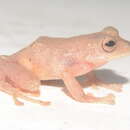en
names in breadcrumbs


Pristimantis eugeniae is a species of frog in the family Strabomantidae.[2]
It is endemic to Ecuador. Its natural habitat is tropical moist montane forests. It is threatened by habitat loss.
{{cite journal}}: CS1 maint: multiple names: authors list (link) Pristimantis eugeniae is a species of frog in the family Strabomantidae.
It is endemic to Ecuador. Its natural habitat is tropical moist montane forests. It is threatened by habitat loss.
Pristimantis eugeniae[1][2][3] es una especie de anfibio anuro de la familia Craugastoridae.
Esta especie es endémica de Ecuador. Habita en las provincias de Pichincha y Cotopaxi entre los 1.700 y 2010 m de altitud en la Cordillera Occidental.[4]
Los machos miden de 25.2 a 26.0 mm y las hembras de 30.5 a 37.6 mm.
Esta especie lleva el nombre en honor a Eugenia María del Pino Veintimilla (1945-).
Pristimantis eugeniae es una especie de anfibio anuro de la familia Craugastoridae.
Pristimantis eugeniae Pristimantis generoko animalia da. Anfibioen barruko Craugastoridae familian sailkatuta dago, Anura ordenan.
Pristimantis eugeniae Pristimantis generoko animalia da. Anfibioen barruko Craugastoridae familian sailkatuta dago, Anura ordenan.
Pristimantis eugeniae est une espèce d'amphibiens de la famille des Craugastoridae[1].
Cette espèce est endémique d'Équateur[1]. Elle se rencontre dans les provinces de Pichincha et de Cotopaxi entre 1 700 et 2 010 m d'altitude dans la cordillère Occidentale.
Les mâles mesurent de 25,2 à 26,0 mm et les femelles de 30,5 à 37,6 mm[2]
Cette espèce est nommée en l'honneur d'Eugenia Maria del Pino Veintimilla (1945-)[2].
Pristimantis eugeniae est une espèce d'amphibiens de la famille des Craugastoridae.
Pristimantis eugeniae é uma espécie de anfíbio da família Craugastoridae.
É endémica do Equador.
Os seus habitats naturais são: regiões subtropicais ou tropicais húmidas de alta altitude.
Está ameaçada por perda de habitat.
Pristimantis eugeniae é uma espécie de anfíbio da família Craugastoridae.
É endémica do Equador.
Os seus habitats naturais são: regiões subtropicais ou tropicais húmidas de alta altitude.
Está ameaçada por perda de habitat.
Eleutherodactylus eugeniae là một loài động vật lưỡng cư trong họ Strabomantidae, thuộc bộ Anura. Loài này được Lynch & Duellman miêu tả khoa học đầu tiên năm 1997.[2] Chúng là loài đặc hữu của Ecuador. Môi trường sống tự nhiên của nó là các khu rừng vùng núi ẩm nhiệt đới hoặc cận nhiệt đới. Loài này đang bị đe dọa do mất môi trường sống.
Eleutherodactylus eugeniae là một loài động vật lưỡng cư trong họ Strabomantidae, thuộc bộ Anura. Loài này được Lynch & Duellman miêu tả khoa học đầu tiên năm 1997. Chúng là loài đặc hữu của Ecuador. Môi trường sống tự nhiên của nó là các khu rừng vùng núi ẩm nhiệt đới hoặc cận nhiệt đới. Loài này đang bị đe dọa do mất môi trường sống.